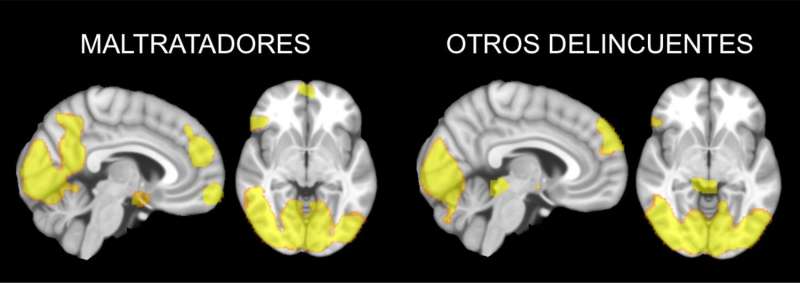Scientific evidence demonstrates that the brain of male batterers functions differently than that of other delinquents

Researchers from the Mind, Brain, and Behavior Center of the University of Granada have analyzed the brain of aggressors against intimate partners through functional magnetic resonance imaging, making it one of only three studies in the world to study this topic. The results from this study may have important implications in better understanding violence against women, as well as the variables related to recidivism in batterers.
The study compares, for the first time in the world, the brain functioning of aggressors against their partners or ex-partners to that of other criminals when they are exposed to images related to different types of violence. This research, whose findings have just been published in the prestigious journal of Social Cognitive and Affective Neuroscience, demonstrates the differences in brain functioning of batterers in response to images related to intimate partner violence (IPV). This study is one of the only three studies in the world to analyze the brain of batterers using functional magnetic resonance imaging.
Specifically, the study carried out by UGR has revealed that batterers, by comparison to other criminals, show a greater activation in the anterior cingulate cortex and in the medial prefrontal cortex, and a smaller reaction in the superior prefrontal cortex in response to images of intimate partner violence as compared to neutral images.
Moreover, the direct comparison of images with different content of violence also supported a profile for brain functioning specific to batterers: There was involvement of the medial prefrontal cortex as well as a strong participation of the posterior cingulate cortex and the left angular gyrus in response to IPV images.
These findings may explain some of the psychological alterations that batterers describe when they encounter their romantic partner, such as maladaptive coping strategies, problems with emotion regulation as manifested by obsessions about their partner, moods such as fear, anger or rage; fear of abandonment, and sudden affective instability in the form of anxiety.
Research coordinator Miguel Pérez García has for years researched the mental and cerebral functioning of batterers, as well as their recidivism profiles. In his view, "the results of these studies could have important implications to better understanding violence against women, as well as the variables that are related to recidivism in batterers."
Neuropsychological sequelae of the victims
The aforementioned studies make up part of a broad area of neuropsychological research on intimate partner violence. UGR researcher Natalia Hidalgo Ruzzante leads a project on neuropsychological sequelae presented in female victims of IPV.
"The women who have suffered intimate partner violence from their partner (or ex-partner) sustain a multitude of physical, psychological, neurological, and cognitive problems as a consequence of abuse. These negative effects can be caused by direct damage as a consequence of hits to the head; but also as indirect damage to the brain through cerebral alterations produced by psychological sequelae (most notably post-traumatic stress) and from the effect of cortisol in situations of chronic stress," Hidalgo explains.
The majority of existing research focuses on physical and psychological disorders, and there are very few studies that have evaluated how abuse can affect the brains of women who have suffered intimate partner violence. According to Hidalgo, it seems clear that these cognitive alterations bring about other associated difficulties in social and work functioning in the affected women.
"An adequate neuropsychological evaluation could delineate the possible cognitive, emotional, and behavioral alterations caused by this brain damage. Currently, battered women are not routinely evaluated for the diagnosis of potential neuropsychological deterioration, and even less when the only precursor is having been a victim of psychological abuse (and not physical)," she explains.
Currently, the efforts of this research group at UGR are focused on the development of batteries for cognitive evaluation and specific rehabilitation programs for neuropsychological sequelae in female victims of violence.
More information: Natalia Bueso-Izquierdo et al. Are batterers different from other criminals? An fMRI study, Social Cognitive and Affective Neuroscience (2016). DOI: 10.1093/scan/nsw020















